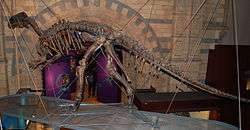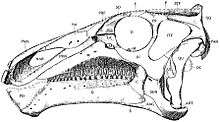Mantellisaurus
| Mantellisaurus Temporal range: Early Cretaceous, 125 Ma | |
|---|---|
 | |
| Holotype skeleton, Natural History Museum, London | |
| Scientific classification | |
| Kingdom: | Animalia |
| Phylum: | Chordata |
| Class: | Reptilia |
| Clade: | Dinosauria |
| Order: | †Ornithischia |
| Suborder: | †Ornithopoda |
| Clade: | †Styracosterna |
| Clade: | †Hadrosauriformes |
| Genus: | †Mantellisaurus Paul, 2007 |
| Species: | †M. atherfieldensis |
| Binomial name | |
| Mantellisaurus atherfieldensis (Hooley, 1925 [originally Iguanodon]) | |
| Synonyms | |
|
Iguanodon atherfieldensis Hooley, 1925 | |
Mantellisaurus is a genus of dinosaur formerly known as Iguanodon atherfieldensis that lived in the Barremian and possibly the early Aptian ages of the Early Cretaceous Period of Europe. Its remains are known from Belgium (Bernissart), England and possibly Germany. The new genus was erected by Gregory Paul in 2007. According to Paul, it is more lightly built than Iguanodon and more closely related to Ouranosaurus, making Iguanodon in its traditional sense paraphyletic. It is known from many complete and almost complete skeletons. The genus name honours Gideon Mantell, the discoverer of Iguanodon. Mantellisaurus lived during the Early Cretaceous in what is now England.
Description

Mantellisaurus was a lightly constructed iguanodont. Compared to Iguanodon bernissartensis, Mantellisaurus was smaller, estimated at 0.75 tons in weight. Its forelimbs were proportionally shorter than those of I. bernissartensis. In Mantellisaurus the forelimbs were about half the length of the hindlimbs whereas they were about 70 percent the length of the hindlimbs in I. bernissartensis. Due to the short length of its forelimbs and the shortness of its body, Paul proposed that it was primarily bipedal, only going on all fours when standing still or moving slowly.[1]
Discovery

The type fossil was originally discovered by Reginald Walter Hooley in 1914 in the upper Vectis Formation of southern England and reported upon in 1917. He posthumously named it Iguanodon atherfieldensis in 1925. Atherfield is the name of a village on the southwest shore of the Isle of Wight where the fossil was found. Synonyms include Dollodon and Proplanicoxa.[2]
Specimen IRSNB 1551 from the Sainte-Barbe Clays, Belgium, became the first ever mounted skeleton of a non-avian dinosaur made primarily out of actual bone when put on display by Louis Dollo in 1891. This specimen was originally assigned to Iguanodon mantelli, but was later thought to pertain to Iguanodon atherfieldensis. The specimen was assigned to its own genus and species, Dollodon bampingi, by Gregory S. Paul in 2008. The genus was named after Dollo, who first described the remains, and the specific name was in honour of popular science writer Daniel Bamping, who assisted Paul in his investigations.[1]

The validity of Dollodon has since been disputed. In 2010, Kenneth Carpenter and Yusuke Ishida synonymized Dollodon bampingi with Iguanodon seelyi, a species based on BMNH R 28685 from Wessex Formation, England.[3] Likewise, David B. Norman and Andrew McDonald do not consider Dollodon a valid genus and instead include it with Mantellisaurus.[4][5][6]
Classification

The cladogram below follows an analysis by Andrew McDonald, 2012.[7]
| Styracosterna |
| ||||||||||||||||||||||||||||||||||||||||||||||||||||||
| |
References
- 1 2 Paul, Gregory S. (2008). "A revised taxonomy of the iguanodont dinosaur genera and species". Cretaceous Research. 29 (2): 192–216. doi:10.1016/j.cretres.2007.04.009.
- ↑ McDonald, Andrew T. (2012). "The status of Dollodon and other basal iguanodonts (Dinosauria: Ornithischia) from the upper Wealden beds (Lower Cretaceous) of Europe". Cretaceous Research. 33: 1–6. doi:10.1016/j.cretres.2011.03.002.
- ↑ Carpenter, K. & Ishida, Y. (2010). "Early and "Middle" Cretaceous Iguanodonts in Time and Space" (PDF). Journal of Iberian Geology. 36 (2): 145–164. doi:10.5209/rev_JIGE.2010.v36.n2.3.
- ↑ Norman, David. (2010). "A taxonomy of iguanodontian (Dinosauria: Ornithopoda) from the lower Wealden Group (Cretaceous: Valanginian) of southern England" (PDF). Zootaxa. 2489: 47–66.
- ↑ McDonald, Andrew T. (2012). "The status of Dollodon and other basal iguanodonts (Dinosauria: Ornithischia) from the upper Wealden beds (Lower Cretaceous) of Europe". Cretaceous Research. 33: 1–6. doi:10.1016/j.cretres.2011.03.002.
- ↑ Norman, D.B., 2012, "Iguanodontian Taxa (Dinosauria: Ornithischia) from the Lower Cretaceous of England and Belgium". In: Pascal Godefroit (ed.), Bernissart Dinosaurs and Early Cretaceous Terrestrial Ecosystems. Indiana University Press. 464 pp. http://www.iupress.indiana.edu/product_info.php?products_id=800408
- ↑ McDonald, A. T. (2012). Farke, Andrew A, ed. "Phylogeny of Basal Iguanodonts (Dinosauria: Ornithischia): An Update". PLoS ONE. 7 (5): e36745. doi:10.1371/journal.pone.0036745. PMC 3358318
 . PMID 22629328.
. PMID 22629328.
- Cornuel, M., 1850, Note sur des ossements fossiles decouvertes dans le calcaire neocomien de Wassy (Haute-Marne): Bulletin de la societie geologiques de France, 2nd series, v. 7, p. 702-704.
- Hooley, W., 1925, On the skeleton of Iguanodon atherfieldensis sp. nov., from the Wealden Shales of Atherfield (Isle of Wight): Quarterly Journal of the Geological Society of London, v. 81, p. 1-61.
- Hulke, J. W., 1879, Vectisaurus valdensis, a new Wealden Dinosaur: Quarterly Journal of the Geological Society of London, v. 35, p. 421-424.
- Owen, R., 1842, Report on British Fossil Reptiles. Part II: Report of the British Association for the Advancement of Science, v. 11, p. 60-204.
- Lydekker, R., 1888, Catalogue of the Fossil Reptilia and Amphibia in the British Museum (Natural History), Cromwell Road, S.W., Part 1. Containing the Orders Ornithosauria, Crocodilia, Dinosauria, Squamta, Rhynchocephalia, and Proterosauria: British Museum of Natural History, London, 309pp.
- Norman, D.B., 2012. "Iguanodontian Taxa (Dinosauria: Ornithischia) from the Lower Cretaceous of England and Belgium". In: Pascal Godefroit (ed.), Bernissart Dinosaurs and Early Cretaceous Terrestrial Ecosystems. Indiana University Press. 464 pp. http://www.iupress.indiana.edu/product_info.php?products_id=800408
- Paul, G.S. 2007. Turning the old into the new: a separate genus for the gracile iguanodont from the Wealden of England; pp. 69–77 in K. Carpenter (ed.), Horns and Beaks: Ceratopsian and Ornithopod Dinosaurs. Indiana University Press, Bloomington.